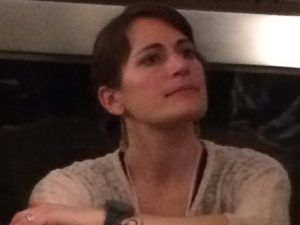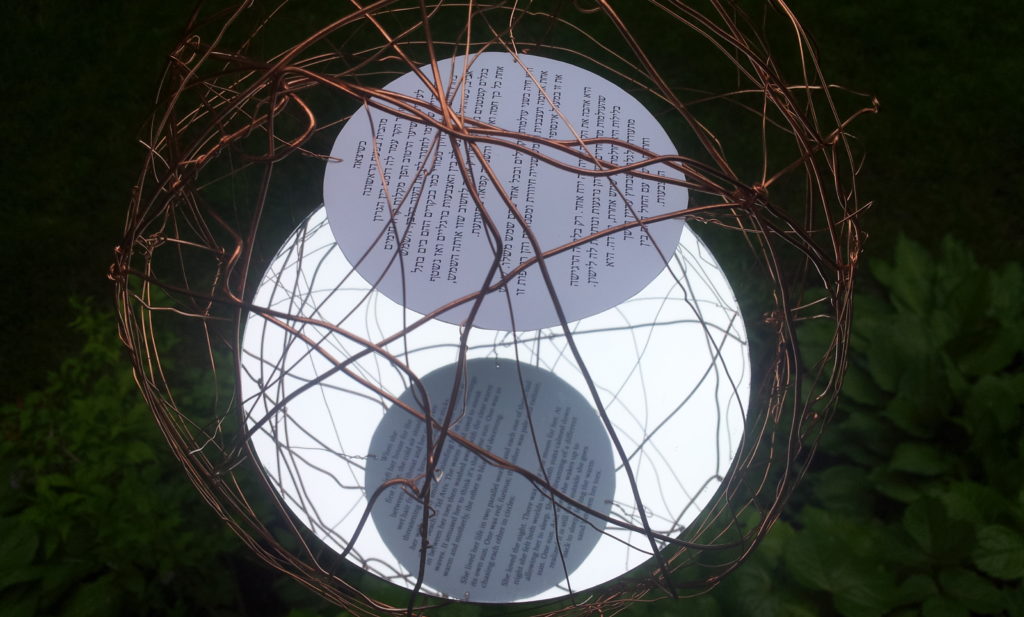A trend has developed in recent years within Jewish communities of artist salons – a way to bring artists together to make art specifically through a Jewish lens. With the help of a grant from the Covenant Foundation a Jewish artist salon sprouted in the Twin Cities, as well as nearby cities of Milwaukee and Madison. The Artists’ Lab is an initiative of Sabes JCC interrelating art and Jewish text. Bringing together 25 local artists plus an artist-in-residence, the Lab is an exploration of Judaism through an artistic perspective.
 Robyn Awend, Director of Visual Arts and Artists’ Lab Coordinator at Sabes JCC has played a central role in this initiative and spoke of the initial purpose of the lab. “You’re reaching people at a very core passion point,” she says. “If they happen to be already connected to Judaism then you have two. And if not you offer a potential gateway to experiencing Judaism through a shared artistic lens.”
Robyn Awend, Director of Visual Arts and Artists’ Lab Coordinator at Sabes JCC has played a central role in this initiative and spoke of the initial purpose of the lab. “You’re reaching people at a very core passion point,” she says. “If they happen to be already connected to Judaism then you have two. And if not you offer a potential gateway to experiencing Judaism through a shared artistic lens.”
Robyn noted that coordinating the lab is one of the favorite parts of her job, in part because she gets to participate as an artist as well.
The lab meets twice a month and attracts artists from many mediums and backgrounds. In addition to the artist participants, the lab consists of text facilitators, Rabbi Alexander Davis and Meryll Page, and arts facilitators Avigail (Avi) Manneberg (Artist in Residence) and Anat Szendro.
Avi and Anat are in their 30s with young families. Both are Israeli and experiencing the displacement which comes with a new home in a new country. Not surprisingly that is reflected in the work each creates.
Avi uses the motif of a sunflower to represent the light that she turns to in her own life.
“It started with my grandmother who was an artist and used to paint sunflowers. I grew up by sunflower fields in Israel so it was always around me and whenever we went to visit her we used to pick up some sunflowers for her to paint…She was a very dominant and important figure in my life. I like to think about the seeds of the sunflower as a cluster of potential.”
In this particular project, I again looked at the sunflower, but this time I was looking at the sunflower more as a symbol of place, thinking about the fact that I left Israel and I moved to Minnesota with my new family. Looking at the sunflower, how it moves with the sun and then thinking about displacement and moving. If the sunflower is looking at the sun and following that, what am I following, what is my sun, what is my light? And then I realized that my current light is really close to me right now, which is my family.
Anat’s work also speaks to the theme of place. As a graphic designer she usually uses a computer in her work, but pushed herself out of her comfort zone to do an installation using wires and mirrors.
I started off writing a text about two suns, a world that has two suns and only one moon. Originally it was written in Hebrew because that’s my comfort zone. And then while trying to translate it into English, I understood a lot of my dualities in life …The sun is a strong duality because the sun here is not the same sun in Israel, … In my work I describe the sun in Israel as very motherly, very warm, red. And the sun over here I feel is pale. It’s a blue sun rather than a red sun and they’re completely different worlds. In my work I talk about my aim is for these two suns to unite in one.
I made a sun out of wire, like a ball out of copper wire. And inside this ball of copper there’s this captive mirror and in this captive mirror you have the original text in Hebrew while the English translation is reflected and enlarged in the reflection. It’s quite small and it’s going to be hanging from the ceiling above a pedestal.
At the beginning of our lab, both Avi and Anat were expecting children. In our first session we talked about our associations with the theme of light and Anat spoke of her child, then still in her womb, and about him floating in the safety of darkness and then entering the world in a shock of light. “You learn from what you don’t know,” she reflected. “From his eyes, everything is new to him. When we see something new, we act like he does, Oh my gosh, what is that?”
Anat spoke of how much she has learned from artists of a different background; and they in turn learned from her, emphasizing the value a diverse group brings to the lab. She also spoke of the value she gained by combining different identities in her life:
“Each artist has different roles in his life. I’m a mother and an artist, I’m a friend, I’m a Jew and an Israeli and each role has its own hat. The Artists’ Lab united some of these. Sometimes it was a friend and the artist. Sometimes it was the artist and the Israeli. Most of the time it was the artist and the Jew. It made things come together. I feel that it is a great privilege to feel comfortable in both hats at once. I really feel that we’ve formed some kind of a family where you can express yourself and not be judged.”
I asked Robyn what the lab would offer to a young artist.
“Artists in their 20s and 30s are juggling a lot [work, family, relationships, etc.] and it can be hard to find that time. This lab is a commitment to be present, and to create new work, and to be part of a Jewish community of dedicated artists.”
With support from the Covenant Foundation, this is a community that’s just getting started.
Or Chadash, A New Light: Unfiltered
Tychman Shapiro Gallery and Shared Walls Exhibition Area
June 12-July 20, 2014
Artists’ Reception June 12 6:00-8:00pm
Closing Presentation July 20 5:00-7:00pm (Readings)
Free and Open to the Public
Read about the lab discussions at our blog.
Susan Weinberg is an artist, writer and public speaker who focuses on themes related to history as expressed through memory. This is her second year in the Artists’ Lab. In addition to her mediums of painting and poetry she is also serving as the Resident Writer and authors the Artists’ Lab blog. You can find her artwork at studio409art.com.



